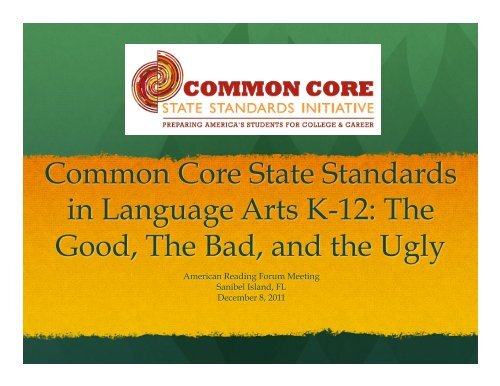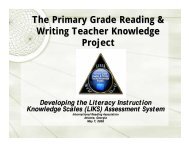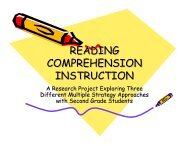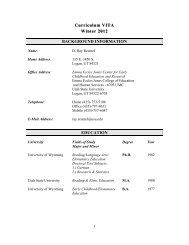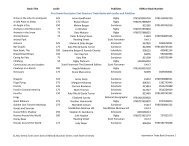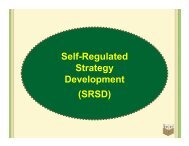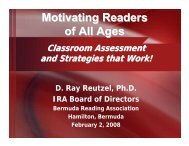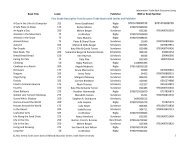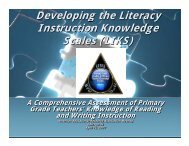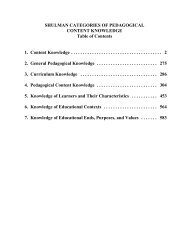Common Core State Standards in Language Arts K-12: The Good ...
Common Core State Standards in Language Arts K-12: The Good ...
Common Core State Standards in Language Arts K-12: The Good ...
You also want an ePaper? Increase the reach of your titles
YUMPU automatically turns print PDFs into web optimized ePapers that Google loves.
<strong>Common</strong> <strong>Core</strong> <strong>State</strong> <strong>Standards</strong><strong>in</strong> <strong>Language</strong> <strong>Arts</strong> K-<strong>12</strong>: <strong>The</strong><strong>Good</strong>, <strong>The</strong> Bad, and the UglyAmerican Read<strong>in</strong>g Forum Meet<strong>in</strong>gSanibel Island, FLDecember 8, 2011
<strong>The</strong> <strong>Good</strong>
<strong>Common</strong> <strong>Core</strong> <strong>State</strong> <strong>Standards</strong> <strong>in</strong> <strong>Language</strong> <strong>Arts</strong>K-<strong>12</strong>: THE GOOD <strong>The</strong> CCSS approached the design process with the“end <strong>in</strong> m<strong>in</strong>d” (Covey, 1989). Students must be college and career ready sostandards were reverse eng<strong>in</strong>eered to produceidentified and desired outcome. No set of <strong>in</strong>puts has been identified that canaccurately predict achiev<strong>in</strong>g the desired outcomes. Places the focus <strong>in</strong> education on standards rather thanon a test<strong>in</strong>g.
<strong>Common</strong> <strong>Core</strong> <strong>State</strong> <strong>Standards</strong> <strong>in</strong> <strong>Language</strong> <strong>Arts</strong>K-<strong>12</strong>:THE GOOD <strong>The</strong> CCSS encourage teachers to use effective<strong>in</strong>struction and evidence-based practices. Don’t throw the baby out with the bathwater! What teachers, researchers, and publishers havelearned <strong>in</strong> the past decade will not become ipso factoobsolete with implementation of the CCSSs.
<strong>Common</strong> <strong>Core</strong> <strong>State</strong> <strong>Standards</strong> <strong>in</strong> <strong>Language</strong> <strong>Arts</strong>K-<strong>12</strong>:THE GOOD <strong>The</strong> CCSS place greater emphasis upon the teach<strong>in</strong>g ofwrit<strong>in</strong>g <strong>in</strong> K-<strong>12</strong> classrooms (narrative, <strong>in</strong>formation,explanation, description, argumentation)! Are we us<strong>in</strong>g what we know about the teach<strong>in</strong>g ofwrit<strong>in</strong>g <strong>in</strong> today’s classrooms?Writer’s Workshop (Pritchard & Honeycutt, 2006; Graham& Sandmel, 2011) Strategy Instruction (Graham, 2006)
<strong>Common</strong> <strong>Core</strong> <strong>State</strong> <strong>Standards</strong> <strong>in</strong> <strong>Language</strong> <strong>Arts</strong>K-<strong>12</strong>:THE GOOD <strong>The</strong> CCSS <strong>in</strong>clude clearly identified and evidence-basedfoundational skills <strong>in</strong> read<strong>in</strong>g and writ<strong>in</strong>g Even though these appeared as “after thoughts” when<strong>in</strong>put was sought about CCSS from primary grade teachers,the <strong>in</strong>clusion of these is critical to firm up the foundation ofthe house of literacy that the subsequent grade levels willbuild upon. Writ<strong>in</strong>g foundational skills are a bit obscured by be<strong>in</strong>glisted under language standards. Inclusion of oral language standards <strong>in</strong> listen<strong>in</strong>g andspeak<strong>in</strong>g so that these language processes get sufficientattention early on and throughout the grades.
<strong>Common</strong> <strong>Core</strong> <strong>State</strong> <strong>Standards</strong> <strong>in</strong> <strong>Language</strong> <strong>Arts</strong>K-<strong>12</strong>:THE GOOD CCSS are descriptive of desired outcomes ratherthan prescriptive of the means to the outcomes. Skills, strategies, and concepts to be taught arethought to be a means to an end and not an end <strong>in</strong>themselves. Know<strong>in</strong>g is not enough, performance throughproduction is the objective. Students must be able toshow what they know by produc<strong>in</strong>g someth<strong>in</strong>g(writ<strong>in</strong>g, PowerPo<strong>in</strong>t, model, etc.) and shar<strong>in</strong>g it withothers. Instructional practices or the “how” to obta<strong>in</strong>outcomes are not prescribed.
<strong>Common</strong> <strong>Core</strong> <strong>State</strong> <strong>Standards</strong> <strong>in</strong> <strong>Language</strong> <strong>Arts</strong>K-<strong>12</strong>: THE GOOD <strong>The</strong> CCSS demand greater attention to read<strong>in</strong>g andwrit<strong>in</strong>g <strong>in</strong>formational text beg<strong>in</strong>n<strong>in</strong>g with a 50/50ratio <strong>in</strong> elementary schools up to a 70/30 ratio <strong>in</strong>high school. Narratives have dom<strong>in</strong>ated elementary schoolclassrooms and secondary English classrooms. A focus on narrative runs counter to the types ofread<strong>in</strong>g most adults do <strong>in</strong> their lives. Most read<strong>in</strong>gand writ<strong>in</strong>g is done for <strong>in</strong>formational purposes.
<strong>Common</strong> <strong>Core</strong> <strong>State</strong> <strong>Standards</strong> <strong>in</strong> <strong>Language</strong> <strong>Arts</strong>K-<strong>12</strong>: THE GOOD <strong>The</strong> CCSS provide specific examples of: Increas<strong>in</strong>gly complex read<strong>in</strong>g texts by grade level Increas<strong>in</strong>gly complex writ<strong>in</strong>g texts by grade level <strong>Standards</strong> from one grade level build upon those ofthe past grade level to “stretch” students’ currentlevels of text process<strong>in</strong>g and production. Stretch<strong>in</strong>g text levels will ensure that U.S. studentsgraduate from high schools read<strong>in</strong>g and writ<strong>in</strong>g textsof similar complexity to <strong>in</strong>ternational comparisongroups.
<strong>Common</strong> <strong>Core</strong> <strong>State</strong> <strong>Standards</strong> <strong>in</strong> <strong>Language</strong> <strong>Arts</strong>K-<strong>12</strong>: THE GOOD <strong>The</strong> CCSS require that students read and write a greaterrange of text types and complexities. Read<strong>in</strong>g and writ<strong>in</strong>g across genres and multiple discoursepatterns is required. Teachers and publishers will need to become conversant <strong>in</strong>the use of “Lexile” level<strong>in</strong>g or similar level<strong>in</strong>g approaches(http://cohmetrix.memphis.edu/cohmetrixpr/<strong>in</strong>dex.html)used to discuss and measure text difficulty levels and otherqualitative factors related to text content, structure,vocabulary, etc. Teachers and publishers will need to cont<strong>in</strong>uously re-teachcomprehension and composition concepts, skills, andstrategies because these are learned “genre” specifically.
<strong>Common</strong> <strong>Core</strong> <strong>State</strong> <strong>Standards</strong> <strong>in</strong> <strong>Language</strong> <strong>Arts</strong>K-<strong>12</strong>: THE GOOD CCSS not only focus on knowledge acquisition fromtexts, but also on craft<strong>in</strong>g texts as demonstrations ofthat learn<strong>in</strong>g. Teachers will need to teach towardproducts and performances. Students will be required to demonstrate learn<strong>in</strong>gthrough the ability to present orally and/or writedigital-visual texts that <strong>in</strong>clude presentations, reports,charts, graphs, etc.
<strong>Common</strong> <strong>Core</strong> <strong>State</strong> <strong>Standards</strong> <strong>in</strong> <strong>Language</strong> <strong>Arts</strong>K-<strong>12</strong>: THE GOOD <strong>The</strong> CCSS demand that teachers and students<strong>in</strong>crease the use of digital media and technologies <strong>in</strong>teach<strong>in</strong>g and learn<strong>in</strong>g. Teachers will need to give more than lip service to theuse of “on-l<strong>in</strong>e” and “off-l<strong>in</strong>e” digital read<strong>in</strong>g andwrit<strong>in</strong>g. <strong>State</strong>s and schools will need to <strong>in</strong>vest heavily <strong>in</strong>provid<strong>in</strong>g students and teachers access to the web andother digital media. Teachers will need to teach students “on-l<strong>in</strong>e”location, evaluation, and authentication strategies for<strong>in</strong>formation – see http://zapatopi.net/treeoctopus/
<strong>Common</strong> <strong>Core</strong> <strong>State</strong> <strong>Standards</strong> <strong>in</strong> <strong>Language</strong> <strong>Arts</strong>K-<strong>12</strong>: THE GOOD <strong>The</strong> CCSS require that teachers, publishers, andstudents learn to collaborate effectively with othersto solve problems of social, economic, ecological andpolitical consequence. Teach students will learn to work <strong>in</strong> teams to useproblem solv<strong>in</strong>g strategies and processes. Teachers will need to use engag<strong>in</strong>g and effective<strong>in</strong>struction approahes and <strong>in</strong>terest<strong>in</strong>g texts <strong>in</strong> read<strong>in</strong>gand writ<strong>in</strong>g, e.g., CORI.
<strong>Common</strong> <strong>Core</strong> <strong>State</strong> <strong>Standards</strong> <strong>in</strong> <strong>Language</strong> <strong>Arts</strong>K-<strong>12</strong>: THE GOOD <strong>The</strong> CCSS require students to support theirarguments, and verify their facts when discuss<strong>in</strong>gtexts, answer<strong>in</strong>g questions about texts, and whenwrit<strong>in</strong>g or present<strong>in</strong>g their thoughts to others. F<strong>in</strong>d<strong>in</strong>g multiple sources of supportive <strong>in</strong>formationfor assertions and arguments <strong>in</strong> texts, traditional anddigital will become an expectation.
<strong>Common</strong> <strong>Core</strong> <strong>State</strong> <strong>Standards</strong> <strong>in</strong> <strong>Language</strong> <strong>Arts</strong>K-<strong>12</strong>: THE GOOD <strong>The</strong> CCSS will require that content area teachers<strong>in</strong>duct the novice learner <strong>in</strong>to an understand<strong>in</strong>g ofthe structures of their respective discipl<strong>in</strong>es byteach<strong>in</strong>g students how to read and writediscipl<strong>in</strong>ary texs. This will require content teachers to <strong>in</strong>tegrate morediscipl<strong>in</strong>e specific language arts content <strong>in</strong>to theircontent <strong>in</strong>struction. This will require language arts and English teachers to<strong>in</strong>tegrate more content specific texts <strong>in</strong>to theirlanguage arts <strong>in</strong>struction.
<strong>The</strong> Bad
<strong>Common</strong> <strong>Core</strong> <strong>State</strong> <strong>Standards</strong> <strong>in</strong> <strong>Language</strong> <strong>Arts</strong>K-<strong>12</strong>: THE BAD <strong>The</strong> CCSS standards cont<strong>in</strong>ue the current focus onbasic skills, read<strong>in</strong>g, writ<strong>in</strong>g, and mathematics, atthe potential expense of develop<strong>in</strong>g a broad, rich,and balanced curriculum focused upon studentslearn<strong>in</strong>g the content and structure of a variety ofacademic discipl<strong>in</strong>es.
<strong>Common</strong> <strong>Core</strong> <strong>State</strong> <strong>Standards</strong> <strong>in</strong> <strong>Language</strong> <strong>Arts</strong>K-<strong>12</strong>: THE BAD <strong>The</strong> nature and content of CCSS assessment rema<strong>in</strong>to be seen. This decisions now rests <strong>in</strong> the hands offederally, NOT STATE, funded groups, SmarterBalance and PARCC. Federal <strong>in</strong>fluence on CCSSassessment could lead to another round of “oldw<strong>in</strong>e <strong>in</strong> new bottles” where the currently mandatedhigh stakes test<strong>in</strong>g and accountability culture iscont<strong>in</strong>ued.
<strong>Common</strong> <strong>Core</strong> <strong>State</strong> <strong>Standards</strong> <strong>in</strong> <strong>Language</strong> <strong>Arts</strong>K-<strong>12</strong>: THE BAD <strong>The</strong> CCSS rely upon the assumption that contentteachers know enough about literacy and literacyteachers know enough about content to be effective<strong>in</strong> address<strong>in</strong>g the desired outcomes withoutsubstantial professional development.
<strong>Common</strong> <strong>Core</strong> <strong>State</strong> <strong>Standards</strong> <strong>in</strong> <strong>Language</strong> <strong>Arts</strong>K-<strong>12</strong>: THE BAD CCSS may lead to a neglect of literature studies. This raises the question…is literature and languagestudy a content discipl<strong>in</strong>e of its own apart from howliteracy is used to process <strong>in</strong>formation? Should we expect that the study of language andliterature will get content area or discipl<strong>in</strong>ary statusunder the CCSS or will these be swept away <strong>in</strong>to theservice of content area studies. What support will be given to secondary Englishliterature teachers when no longer teach muchliterature and <strong>in</strong>stead teacher mostly technical and<strong>in</strong>formation read<strong>in</strong>g and writ<strong>in</strong>g?
<strong>Common</strong> <strong>Core</strong> <strong>State</strong> <strong>Standards</strong> <strong>in</strong> <strong>Language</strong> <strong>Arts</strong>K-<strong>12</strong>: THE BAD <strong>The</strong> CCSS assume that teachers are competentwriters themselves. What supports will be needed to improve teachers’writ<strong>in</strong>g abilities? What supports will be needed to improve teachersknowledge of the teach<strong>in</strong>g of writ<strong>in</strong>g – especially asthis perta<strong>in</strong>s to an expanded range of <strong>in</strong>formationwrit<strong>in</strong>g?
<strong>Common</strong> <strong>Core</strong> <strong>State</strong> <strong>Standards</strong> <strong>in</strong> <strong>Language</strong> <strong>Arts</strong>K-<strong>12</strong>: THE BAD <strong>The</strong> CCSS provide NO specific guidance to teachersas to “best” or “evidence-based” <strong>in</strong>structionalpractices <strong>in</strong> literacy or <strong>in</strong> content discipl<strong>in</strong>es. Without such guidance are teachers sufficiently wellgrounded <strong>in</strong> the research literature around effectivepractices to know and use such practices? Will this assumption lead to yet another round ofmandat<strong>in</strong>g the use of published materials that claim toaddress the CCSS at local levels?
<strong>Common</strong> <strong>Core</strong> <strong>State</strong> <strong>Standards</strong> <strong>in</strong> <strong>Language</strong> <strong>Arts</strong>K-<strong>12</strong>: THE BAD <strong>The</strong> CCSS focus on outcomes and not <strong>in</strong>puts. Assuch, no particular educational or preparatoryexperiences are presumed necessary to effectivelyteach the CCSS standards. Do teachers need anyprofessional knowledge or preparation to teach? Orare the CCSS simply tak<strong>in</strong>g up the popular federalposition, similar to Chef Gusteau <strong>in</strong> Ratatouille –Any One Can Cook!
<strong>Common</strong> <strong>Core</strong> <strong>State</strong> <strong>Standards</strong> <strong>in</strong> <strong>Language</strong> <strong>Arts</strong>K-<strong>12</strong>: THE BAD <strong>The</strong> CCSS assume that content and literacy teachersunderstand elements of text complexity, bothquantitative and qualitative, <strong>in</strong> order to be able tomatch complex texts to student capacity. What makes a text difficult to read? Topical or <strong>The</strong>matic Knowledge Top Level Structure/Features Vocabulary Readability
<strong>Common</strong> <strong>Core</strong> <strong>State</strong> <strong>Standards</strong> <strong>in</strong> <strong>Language</strong> <strong>Arts</strong>K-<strong>12</strong>: THE BAD <strong>The</strong> CCSS failed to carefully <strong>in</strong>tegrate the languagearts, e.g., read<strong>in</strong>g comprehension and writ<strong>in</strong>gcomposition, <strong>in</strong> ways that support and susta<strong>in</strong>student learn<strong>in</strong>g as reciprocal language processes.For example: Text structures taught for comprehend<strong>in</strong>g <strong>in</strong>formationtexts: description, sequence, cause effect, comparecontrast, and problem solution. Text types <strong>in</strong> <strong>in</strong>formation text composition <strong>in</strong>struction:op<strong>in</strong>ion, persuasion, description, explanation, etc. Does read<strong>in</strong>g serve as a model forwrit<strong>in</strong>g and vice versa?
<strong>Common</strong> <strong>Core</strong> <strong>State</strong> <strong>Standards</strong> <strong>in</strong> <strong>Language</strong> <strong>Arts</strong>K-<strong>12</strong>: THE BAD Will the CCSS text examples and titles result <strong>in</strong> anational required lists of books to be read ratherthan encourag<strong>in</strong>g teachers and students to expandthe types of texts to be read <strong>in</strong> classrooms? Will future CCSS test<strong>in</strong>g re<strong>in</strong>force the potential forexample texts becom<strong>in</strong>g a required read<strong>in</strong>g list?
<strong>The</strong> Ugly
How the Once <strong>Common</strong> <strong>Core</strong> <strong>State</strong><strong>Standards</strong> May Become Federal<strong>Standards</strong>
THE UGLY“Our Nation is at risk. Our onceunchallenged preem<strong>in</strong>ence <strong>in</strong>commerce, <strong>in</strong>dustry, science,and technological <strong>in</strong>novation isbe<strong>in</strong>g overtaken by competitorsthroughout the world.”
<strong>The</strong> UGLY“If an unfriendly foreign powerhad attempted to impose onAmerica the mediocreeducational performance thatexists today, we might well haveviewed it as an act of war. ”
<strong>The</strong> UGLYWhile We Were Asleep“Change is hardest on those caughtby surprise. Change is the hardeston those who have difficultychang<strong>in</strong>g too. But change is natural;change is not new, change isimportant.”
<strong>The</strong> UGLYTen Forces thatFlattened theWorld: A CausalCha<strong>in</strong> at Work?
<strong>The</strong> UGLY#1. When the wall came down and the w<strong>in</strong>dows went up.#2. When Netscape went public.#3. Work flow software.#4. Open sourc<strong>in</strong>g.#5. Outsourc<strong>in</strong>g.#6. Offshor<strong>in</strong>g: Runn<strong>in</strong>g with Gazelles; Eat<strong>in</strong>g with Lions.#7. Supply Cha<strong>in</strong><strong>in</strong>g: Eat<strong>in</strong>g Sushi <strong>in</strong> Arkansas.#8. Insourc<strong>in</strong>g: What the Guys <strong>in</strong> Funny Brown Shorts are Really Do<strong>in</strong>g.#9. In-form<strong>in</strong>g: Google, MSN, Yahoo Web Search#10. <strong>The</strong> Steroids: Digital, Mobile, Personal, andVirtual
<strong>The</strong> Ugly" My advice to you is: “Girls, f<strong>in</strong>ish yourhomework – people <strong>in</strong> Ch<strong>in</strong>a and India arestarv<strong>in</strong>g for your jobs.”" Bill Gates, “the more educated you are, the moreoptions you will have <strong>in</strong> a flat world.”" Have we really been <strong>in</strong>vest<strong>in</strong>g <strong>in</strong> our future andprepar<strong>in</strong>g our children the way we need to for therace ahead? <strong>The</strong> answer is: NO.
Don’t Miss theSequel!
<strong>The</strong> Ugly…And the theme cont<strong>in</strong>ues with publiceducation (and teacher education) <strong>in</strong> the crosshairs…Five Pillars of Prosperity" Public education" Build<strong>in</strong>g and moderniz<strong>in</strong>g of <strong>in</strong>frastructure" Open doors to immigration" Government support for research anddevelopment" Necessary regulations on private economicactivity
<strong>The</strong> Ugly“As a country we have not yet adapted to thisnew reality. We don’t th<strong>in</strong>k of education asan <strong>in</strong>vestment <strong>in</strong> national growth andnational security because throughout ourhistory it has been a localized, decentralizedissue, not a national one. Today, however,what matters is not how your local schoolranks <strong>in</strong> its county or state but howAmerica’s schools rank <strong>in</strong> the world.”
<strong>The</strong> Ugly“America needs to close two education gaps atonce. We need to close the gap between black,Hispanic, and other m<strong>in</strong>ority students and theaverage for white students on standardizedread<strong>in</strong>g, writ<strong>in</strong>g, and math tests. But we have anequally dangerous gap between what theaverage American student and the averagestudents <strong>in</strong> many <strong>in</strong>dustrial countries that weconsider collaborators and competitors <strong>in</strong>clud<strong>in</strong>gS<strong>in</strong>gapore, Korea, Taiwan, F<strong>in</strong>land and those <strong>in</strong>the most developed parts of Ch<strong>in</strong>a.”
<strong>The</strong> UglyAND THE THEME CONTINUES WITHA FEW FACTIODS…" Thirty years ago, ten percent of California’s generalfund went to higher education and three percent toprisons. Today, nearly eleven percent goes to prisonsand eight percent to higher education." Ch<strong>in</strong>a is now second <strong>in</strong> the world <strong>in</strong> its publication ofbiomedical research articles, hav<strong>in</strong>g recentlysurpassed Japan, the United K<strong>in</strong>gdom, Germany,Italy, France, Canada and Spa<strong>in</strong>." In 1998 Ch<strong>in</strong>a produced about 20,000 research articles,but by 2006 the output had reached 83,000 . . .overtak<strong>in</strong>g Japan, Germany and the U.K.
<strong>The</strong> UglyAND THE THEME CONTINUES WITHA FEW FACTIODS…" Forty-n<strong>in</strong>e percent of United <strong>State</strong>s adults do notknow how long it takes for the Earth to revolvearound the Sun." Youths between the ages of 8 and 18 average sevenand-a-halfhours a day <strong>in</strong> front of video games,television and computers—often multi-task<strong>in</strong>g." In 2007 Ch<strong>in</strong>a became second only to the United<strong>State</strong>s <strong>in</strong> the estimated number of people engaged <strong>in</strong>scientific and eng<strong>in</strong>eer<strong>in</strong>g research and development.
<strong>The</strong> Ugly “Clearly our Asian counterparts have taken a verydifferent – <strong>in</strong> fact, opposite – approach <strong>in</strong> theireducation reforms. While the U.S. is mov<strong>in</strong>gtoward more standardization and centralization,the Asian countries are work<strong>in</strong>g hard to allowmore flexibility and autonomy at the local level…While the U.S. is rais<strong>in</strong>g the stakes on test<strong>in</strong>g, theAsian countries are exert<strong>in</strong>g great efforts to reducethe power and pressure of test<strong>in</strong>g…
<strong>The</strong> Ugly “In this spirit, schools should offer acomprehensive, balanced curriculum that <strong>in</strong>cludesopportunities for students to explore and… tolearn math, science, technology, history,economics, geography, government, read<strong>in</strong>g,literature, music, foreign languages, and art; todevelop global awareness and appreciation fordifferences; to develop understand<strong>in</strong>g of andability to <strong>in</strong>teract with<strong>in</strong> the digital virtual world;and to develop a healthy body and m<strong>in</strong>d.
<strong>The</strong> Ugly
<strong>The</strong> Ugly “…great teachers are the key. Research shows, <strong>in</strong>fact, that the s<strong>in</strong>gle most important factor <strong>in</strong>improv<strong>in</strong>g student achievement is great teach<strong>in</strong>g(pg. 53).” “<strong>The</strong> only th<strong>in</strong>g that matters is results for kids! (pg.56).” “<strong>The</strong>re is irony <strong>in</strong> that we encourage creativity <strong>in</strong> ourkids here <strong>in</strong> the United <strong>State</strong>s and yet we don’t encouragecreativity <strong>in</strong> how we run our schools. This is anotherreason we are not produc<strong>in</strong>g results…(pg. 56).”
<strong>The</strong> Ugly “<strong>The</strong>re is no doubt that family is very important <strong>in</strong><strong>in</strong>fluenc<strong>in</strong>g a student’s preparation for learn<strong>in</strong>g.But, family is not dest<strong>in</strong>y. <strong>The</strong> estimates of teacherperformance we’ve cited suggest that hav<strong>in</strong>g threeto four years of good teachers (85 th percentile) <strong>in</strong> arow would generally over come the averageachievement deficit between low-<strong>in</strong>come kids andothers…Unfortunately the current school systemdoes not ensure any such three- or four-year run ofhigh-quality teachers (pg. 84).”Eric HanushekPaul and Jean Senior Hanna FellowHoover Institute of Stanford University
<strong>The</strong> Ugly “Recent efforts to develop common standards andtest<strong>in</strong>g across wider groups of states appear verysensible (pg. 97).”Eric HanushekPaul and Jean Senior Hanna FellowHoover Institute of Stanford University
<strong>The</strong> Ugly“<strong>The</strong> whole education system is built onthree pillars of mediocrity: lockstep pay,life tenure, and seniority. Until we buildit on a foundation of performance,accountability, and excellence, we won’tsucceed.” Joel Kle<strong>in</strong>“Schools are not adult employmentcenters.” Michelle Rhee
<strong>The</strong> UglyWhat do you know about these characters?Jon SchnurKati HaycockEli Broad Wendy KoppAlan Bers<strong>in</strong>Michael JohnstonWhitney Tilson Randi We<strong>in</strong>gartenJoel Kle<strong>in</strong> David GuggenheimEric Hanushek Democrats forEducational Reform
<strong>The</strong> UglyReformers <strong>in</strong>cluded - “TFA alums andother reformers <strong>in</strong> Schnur’s network;academics like Kane; money people likeBroad, Gates, the hedge funders, andthe billionaires <strong>in</strong> the elevator; charteroperators; parents from Harlem to LosAngeles who saw that there was analternative... And Democrats who werewill<strong>in</strong>g to jo<strong>in</strong> Republicans like JebBush <strong>in</strong> confront<strong>in</strong>g the unions,<strong>in</strong>clud<strong>in</strong>g the Democratic presidentwho set off the imperfect but pivotalrace to the top”
<strong>The</strong> Ugly Speak<strong>in</strong>g of NCLB . . . “For the firsttime, all across the country, studentperformance was be<strong>in</strong>g tied to everyschool, and demographics were be<strong>in</strong>gtied to every measure”
<strong>The</strong> Ugly“By spr<strong>in</strong>g of 2011, an unlikelyconvergence of forces had madestunn<strong>in</strong>g headway <strong>in</strong> push<strong>in</strong>g an agenda…that A Nation at Risk warned nearlythirty years before was so urgent.”
And then there is traditional teachereducation….
<strong>The</strong> Ugly“<strong>The</strong> ideal is to encourage the development ofteachers and other educators who are truly‘reflective practitioners,’ able to draw on theoryto <strong>in</strong>form practice. <strong>The</strong> flip side of this aim isto encourage university professors to becomepractice-oriented theoreticians, able to draw onissues from practice <strong>in</strong> their theory build<strong>in</strong>gand to produce theories with potential usevalue. That is the ideal. But no one wouldargue that education schools come close tomeet<strong>in</strong>g this ideal”
<strong>The</strong> Ugly“Oddly enough, the rest of the university couldlearn a lot from the example of the ed school…But it seems more likely that academics willconsider this a cautionary tale about how riskyand unreward<strong>in</strong>g such a strategy can be. Afterall, education schools have demonstrated thatthey are neither very successful ataccomplish<strong>in</strong>g the marriage of theory andpractice nor well rewarded for try<strong>in</strong>g.”
<strong>The</strong> Ugly“<strong>The</strong> education of teachers <strong>in</strong> the United <strong>State</strong>s needsto be turned upside down. To prepare teachers for 21 stcentury classrooms, teacher education must shift awayfrom a norm which emphasizes academic preparationand course work loosely l<strong>in</strong>ked to school-basedexperiences. Rather it must move to programs that arefully grounded <strong>in</strong> cl<strong>in</strong>ical practice and <strong>in</strong>terwovenwith academic content and professional courses…Inorder to make this change, teacher education programsmust work <strong>in</strong> close partnership with school districts toredesign teacher preparation to better serveprospective teachers and the students they teach.”
<strong>The</strong> Ugly“All teacher education programs shouldbe accountable for – and theiraccreditation cont<strong>in</strong>gent upon – how wellthey address the needs of schools andhelp improve P-<strong>12</strong> student learn<strong>in</strong>g…This will require more rigorousmonitor<strong>in</strong>g and enforcement for programapproval and accreditation …”
And the recent lamentations of aneducational reformer….
<strong>The</strong> Ugly“<strong>The</strong> standards movement died <strong>in</strong>1995, when the controversy overthe national history standardscame to a high boil…NCLB wasall sticks and no carrots. Testbasedaccountability – notstandards – became our nationaleducation policy.”
<strong>The</strong> Ugly“..we should attend to the quality of thecurriculum – that is, what is taught. Everyschool should have a well-conceivedcoherent, sequential curriculum. Acurriculum is not a script but a set ofguidel<strong>in</strong>es…To paraphrase the Cheshire cat<strong>in</strong> Alice <strong>in</strong> Wonderland, if you don’t knowwhere you are go<strong>in</strong>g, any road will get youthere. <strong>The</strong> curriculum is a start<strong>in</strong>g po<strong>in</strong>t forother reforms.”
<strong>The</strong> Ugly“<strong>The</strong> Democrats for EducationalReform’s (DFER) vast f<strong>in</strong>ancialresources imported the Republicanagenda <strong>in</strong>to the Democratic Party.DFER’s <strong>in</strong>terests and strategies, evenits membership, overlap with similargroups such as Education ReformNow, the Education Equality Project,and Stand for Children…”
<strong>Common</strong> <strong>Core</strong> <strong>State</strong> <strong>Standards</strong>:<strong>The</strong> <strong>Good</strong>, <strong>The</strong> Bad and <strong>The</strong>Ugly" Information technologies and social mediahave leveled the economic play<strong>in</strong>g field<strong>in</strong>ternationally." U.S. schools are not produc<strong>in</strong>g studentswho are competitive among otherdeveloped nations and economies for thejobs of the future." U.S. schools do not focus rewards oraccountability on add<strong>in</strong>g to students’learn<strong>in</strong>g or on the quality of thecurriculum.
<strong>Common</strong> <strong>Core</strong> <strong>State</strong> <strong>Standards</strong>:<strong>The</strong> <strong>Good</strong>, <strong>The</strong> Bad and <strong>The</strong>Ugly" Change is com<strong>in</strong>g to U.S. schools and theteacher education system from outside theeducational establishment." <strong>The</strong> “standards” reform movement washijacked by the test<strong>in</strong>g, school choice, andteacher quality/effectiveness movement." Do the <strong>Common</strong> <strong>Core</strong> <strong>State</strong> <strong>Standards</strong>represent a much needed course correction<strong>in</strong> educational reform or one more stanzaof the same old song?
<strong>Common</strong> <strong>Core</strong> <strong>State</strong> <strong>Standards</strong> <strong>in</strong> <strong>Language</strong> <strong>Arts</strong>K-<strong>12</strong>:<strong>The</strong> GOOD, <strong>The</strong> BAD, and <strong>The</strong> UGLYD. Ray Reutzel, Ph.D.Emma Eccles Jones Endowed Chair ProfessorUtah <strong>State</strong> Universitywww.cehs.usu.edu/eccPresentations Button Left Hand Side


